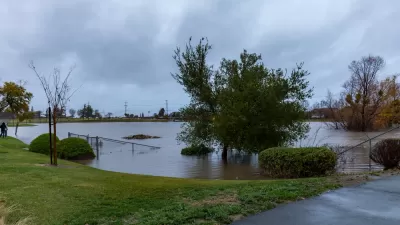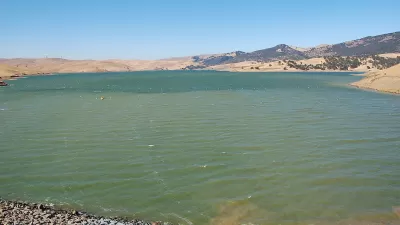The state is slowly starting to curb water consumption, but progress has been ‘disappointingly slow’ as water supplies across the West diminish to historic lows.

Californians are saving more water, but it’s still not enough to meet Governor Newsom’s goal of reducing water use by 15 percent, reports Hayley Smith in the Los Angeles Times. “After months of middling efforts — including a 17.6% increase in urban water use in April — residents in May saved 3.1% more water than in the same month in 2020, the baseline year against which current data are measured, according to new figures from the State Water Resources Control Board.”
Since April, “The latest figures indicate the message is seeping in, albeit only slightly, with the South Coast hydrologic region that is home to Los Angeles eking out a 2.2% savings in May.” According to Peter Gleick, co-founder and senior fellow of the Pacific Institute, “It’s progress in the right direction, but it’s still disappointingly slow.” The article indicates that Californians only cut water use by 2 percent since last July.
“On June 10, the water board required all urban water suppliers to implement Level 2 of their emergency drought restrictions. It also took the step of banning the irrigation of “nonfunctional grass,” or grass that is purely decorative, at businesses and in common areas of subdivisions and property controlled by homeowner associations.” The decision comes as the state’s largest reservoir, Lake Shasta, sits at 39 percent of capacity, “about half its average for this time of year.”
Smith writes that “The [2022-2023 state budget] allocates $2.8 billion for drought response and water resilience, officials said, including $175 million for water-saving strategies such as turf replacement.” According to a separate article in WaterWorld, the California Department of Water Resources (DWR) just awarded $2 million to four water conservation projects aimed at improving drought resilience.
FULL STORY: California is finally reducing water use, but it’s not enough amid severe drought

Montreal Mall to Become 6,000 Housing Units
Place Versailles will be transformed into a mixed-use complex over the next 25 years.

Planetizen Federal Action Tracker
A weekly monitor of how Trump’s orders and actions are impacting planners and planning in America.

DARTSpace Platform Streamlines Dallas TOD Application Process
The Dallas transit agency hopes a shorter permitting timeline will boost transit-oriented development around rail stations.

Congressman Proposes Bill to Rename DC Metro “Trump Train”
The Make Autorail Great Again Act would withhold federal funding to the system until the Washington Metropolitan Area Transit Authority (WMATA), rebrands as the Washington Metropolitan Authority for Greater Access (WMAGA).

Trump's “Able Bodied” Public Housing Limits Could Displace Over 300,000 New Yorkers
As part of 43% cut to federal rental assistance, Trump is proposing a two-year limit on public housing tenure for “able bodied adults.”

Nine Ways to Use Curb Space That Aren’t Parking
California’s new daylighting law bans parking within 20 feet of crosswalks. How can cities best use this space?
Urban Design for Planners 1: Software Tools
This six-course series explores essential urban design concepts using open source software and equips planners with the tools they need to participate fully in the urban design process.
Planning for Universal Design
Learn the tools for implementing Universal Design in planning regulations.
City of Mt Shasta
City of Camden Redevelopment Agency
City of Astoria
Transportation Research & Education Center (TREC) at Portland State University
City of Camden Redevelopment Agency
Municipality of Princeton (NJ)
Regional Transportation Commission of Southern Nevada





























